Characteristically for an avant-garde grouping, the Nul artists presented themselves as something new. As stated in the catalogue for their 1965 exhibition at the Stedelijk Museum, Amsterdam, ‘Nul wants to stand for a new start, more an idea or a climate than a particular style or a form; it wants to distance itself from what no longer has any capacity for life, from painting if need be.’1 In the same catalogue Peeters commented that ‘my work is approximately 2% op art and even that is too much for me’.2 The break with painting, proposed here as being due to its unreal aspects, belies not only Peeters’s long and deep engagement with painting prior to Nul but also the position of works such as Burn Hole 1961 (Tate T13407) as transitional between abstract painting and the forms of object making he would pursue subsequently. On close inspection we find that the concern for ‘reality’ that is expressed by Peeters and other Nul artists can be found in artistic debates throughout the immediate post-war period, debates in which the artist quickly became deeply involved.
Peeters’s artistic career had begun in earnest with the liberation of the Netherlands from Nazi occupation in 1945, a situation that thrust him directly into heated disputes concerning the proper direction for art following a period of unprecedented state control of art, the repression of free expression and violence against artists. During the war, Peeters had clandestinely associated with artists who believed strongly in the potential for geometric abstract art to provide a model for the total remaking of social relations, a utopian position commonly held prior to the war. Together, Peeters and artists such as Willem Schrofer, in whose studio secret meetings often took place, dreamed of a better future they could build once the war was over.3 When that moment arrived, however, Peeters’s position changed rapidly in favour of realism. Peeters came from a family of committed communists and his viewpoints on art were shaped by ongoing divisions among left-thinking artists and intellectuals.4
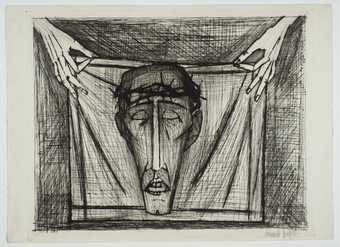
Fig.1
Bernard Buffet
Holy Face 1953
Tate P77136
© ADAGP, Paris and DACS, London 2019
It was not only in the Netherlands that such debates were taking place. In 1947 Peeters went to Paris for an extended visit and returned to France frequently over the next decade. There he witnessed the French Communist Party’s rejection of abstract painting in favour of socialist realism. Peeters’s paintings soon took on the grim character of Bernard Buffet’s interior scenes, which often showed blankly looking, isolated individuals in stark and oppressive settings (fig.1). According to the French critic Claude Roger-Marx, Buffet’s paintings reflected ‘a generation born into suffering’ and what linked his art to that of his contemporaries was ‘what they all breathed as children, the same cellar air, the terror, the restrictions’.5 This was a realism that reflected on a terrible present by drawing on ancient prototypes for the depiction of human misery, tapping into a religious spirit, haunted, as Roger-Marx put it, by ‘the horrible and the bloody’.6
It should be noted that Peeters was not so drawn to André Fougeron, the French Communist Party’s champion in the so-called battle between realism and abstraction whose celebrated Parisiennes at the Market 1947–8, depicting stoic French women at a less than attractive fish stall, is seen to have sparked the debate in 1948.7 Fougeron received a full-page panegyric in the Dutch Communist Party newspaper De Waarheid (The Truth) in 1951, complete with an epigram from one of France’s leading communist intellectuals, Louis Aragon.8 The article in De Waarheid focussed on an exhibition in which Fougeron displayed a large number of works made during a six month period living in a mining community and compared his attitude to that of the nineteenth-century painter Van Gogh; its argument was that one should identify entirely with one’s subjects in order to paint them successfully.9 The debate over realism extended much further than questions of resemblance. It was a matter of commitment.
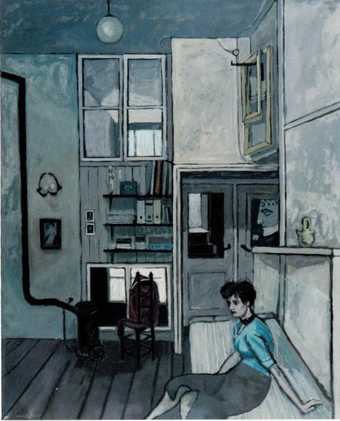
Fig.2
Henk Peeters
Atelier II 1953
Estate of Henk Peeters
© Estate of Henk Peeters
Peeters’s paintings of this time represented a rather different world to that of working class life, concentrating primarily on barely active individuals, who appear disengaged and self-absorbed. In the high-ceilinged, spartan rooms they occupy, expanses of empty space bear down on them and large parts of the canvasses are made up of shifting swathes of grey paint (fig.2). In the battle between realism and abstraction, Peeters was not as concerned with class solidarity as he was with the question of how art could possibly address contemporary reality. Where was the truthfulness in depicting heroic workers in an era traumatised by war, occupation, the legacies of resistance and collaboration, torture, mass killing, ongoing privation and threats of further conflict in a nuclear age?
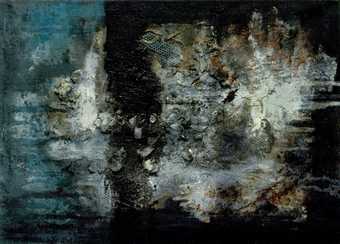
Fig.3
Henk Peeters
58–24 1958
Gauze, gypsum and paint on jute
500 x 700 mm
Estate of Henk Peeters
© Estate of Henk Peeters
Such debates concerning the bleakness of contemporary life, and one haunted by recent experience, provided the context for Peeters’s return to abstraction in the later 1950s. In the years 1955–7 Peeters did not exhibit and there is hardly any work to show that he was active as an artist at this time.10 In 1958 he returned to the scene with vigour and took part in two exhibitions in The Hague and Dordrecht. There he showed heavily worked canvases thick with paint that he sometimes mixed with sand, plaster or other materials to increase its physicality and presence (see, for instance, 58–24 1958; fig.3). This was a different but related approach to the treatment of the artwork as a physical object to the seeming slightness of Burn Hole. Hard on the exhibition’s heels, Peeters took part in a show of Informele Kunst (Informal Art), which travelled from Delft to The Hague and Leiden. It used for its title a Dutch adaptation of the French term art informel, one that had been introduced by the French critic Michel Tapié in 1951 to describe a kind of gestural, material abstract painting.11 By the end of 1959 some of the artists who took part in this exhibition, including Peeters, styled themselves the Nederlandse Informele Groep (Dutch Informal Group). Its most prominent member was perhaps Armando, the response to whose work had established the terms by which art informel was understood in the Netherlands.
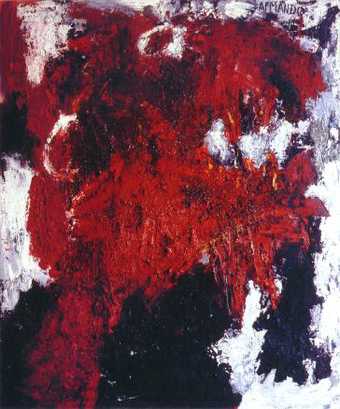
Fig.4
Armando
Peinture criminelle 5 1956
Museum Voorlinden, Wassenaar
© Estate of Armando (Herman Dirk van Dodeweerd)
Armando had been generating powerful critical reactions to his paintings for a number of years prior to the appearance of the Nederlandse Informele Groep, partly by giving them extreme titles and presenting them as threatening or dangerous. In 1956 he exhibited a violently red, monochrome painting in Dordrecht and Amsterdam, which he titled Peinture criminelle 5 (Criminal Painting 5) (fig.4). Armando grew up in the vicinity of the concentration camp in Amersfoort and the theme of the Holocaust remains constant in his career.12 Peeters visited an Armando exhibition in Amsterdam in 1957 and would have been able to see for himself what one critic described as a kind of protest: ‘Armando wants to shock, wants to provoke … He feels the threat that he himself summons up, but does not have the strength to translate it into pictures.’13 The provocation had certainly worked shortly beforehand to whip up a flurry of letters of protest to the national paper, Het Parool, and for its critic to warn against what he thought was a ‘stupefied and nihilistic’ art.14
Some of the criticism directed at Armando rubbed off on Peeters, who was similarly accused of making works inspired by mental disturbance, of meddling with dangerous and unhealthy unconscious forces.15 While much of that publicity served to get him noticed, the stakes were heightened in March 1959 when Adri Laan, the art critic of the social-democratic paper Het Vrije Volk (The Free People), brought to the attention of his readers that Peeters was one of two of the artists exhibiting under the banner of Informele Kunst who had teaching positions at the Arnhem Academy of Fine and Applied Arts.16 According to Laan, the institution needed to think carefully about its direction and its employment policy. Laan repeated his warning one month later, ‘When the artist has a tolerant view of life there is little danger. But for these intolerant Informals, who are dogmatic, the rest of the world is out of line.’17
Laan referred to ‘little danger’ by using a highly idiomatic phrase, weinig vuil aan der lucht, meaning literally ‘little dirt in the air’ and associatively ‘hardly a cloud in the sky’, something like the English phrase, ‘no trouble on the horizon’. Peeters immediately appropriated the phrase and used it as the title of a declaration he made in the catalogue of the next Informele Groep exhibition in July 1959, but dropped the negative. In his text, ‘Vuil aan der lucht’ (Dirt in the Air), Peeters stated that ‘chaos is my only certainty and source of creativity, my work more real, de-illusionised and more natural, than posited as dependent on the “inspiration” of a highly accidental coincidence of circumstances, registered by the least trustworthy sense organ.’18 ‘Dirt in the air’, like smoke in the eyes, obscures vision. Like smoke, though, it is a direct index; it points to something beyond itself, in this case fire, destruction and danger, things to which we must pay serious heed. Not for the last time was Peeters to link an idea of total content with something insubstantial and apparently contentless.
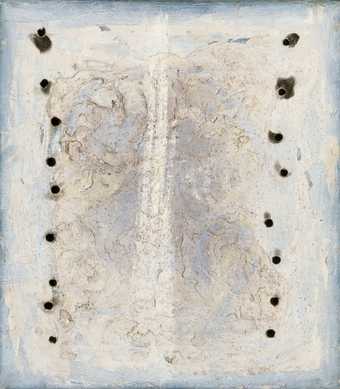
Fig.5
Henk Peeters
59–14 1959
Oil, burn holes and plaster on perforated canvas
455 x 450 mm
Stedelijk Museum, Amsterdam
© Estate of Henk Peeters
It is in this context that we find the first works by Peeters to feature holes produced by burning. 59–14 1959 (fig.5), an informel painting where the voids punctured in the canvas contrast with a physically dense surface built up with plaster, might indeed be the very first of these.19 Here, the paint has been pushed, scraped and hauled around to emphasise its weight and obduracy rather than its potential as an expressive medium. A broken stripe of whitish paint dragged vertically down the middle sets up a bilateral composition to the painting, and vertical lines of holes burned in the canvas (possibly using a cigarette) at left and right almost mirror each other. But this is not geometric abstraction returning here. Compositional niceties (the balancing of interconnected parts) have been eradicated and replaced with an almost arbitrary arrangement derived from the structure of the canvas stretcher. The relation of the holes to the implacable lumpenness of the painting is intriguing, though, and here we need to pay attention to the effect of the smoke, the ‘dirt in the air’. It both sits on the surface, soiling it, and at the same time creates the appearance of shadows that seem to be behind the holes and push them forward to make them seem material and solidify nothingness in our field of vision. Very soon after he made 59–14, Peeters dispensed with paint altogether and made works he called ‘pyrographies’ (fire drawings), solely featuring holes burned into canvas. A practice that has been associated with the anti-art nature of Nul was therefore fully developed in the context of art informel.
Despite the wave of negative criticism they had been receiving, the ‘Informals’ were not without significant supporters, one of whom was Hans Jaffé, a prominent art historian and curator.20 He grasped something of the connection Peeters was drawing between abstraction and realism, between the often abject and anti-aesthetic surfaces of informel paintings and the artists’ disquiet with contemporary society, and, in a foreword for a catalogue to accompany a travelling Informele Groep show that toured Europe in 1960–1, produced one of the most potent associations for Dutch informel art one could possibly imagine. Jaffé began his text with the innocent metaphor of cooking, which he used to criticise the capability of the ‘haute cuisine’ of recent art to sate the ‘spiritual hunger’ of the age. However, he concluded more compellingly by contrasting the finery of much abstract painting to ‘the facts with which a group of young dutchmen here confronts you, [which] belong to another category: facts such as the tulip bulbs which during the war in Holland did not attain their colorful blossoms, but which were the only nourishment for many dutchmen – without which they would have starved.’21
Jaffé’s stark reference is to the ‘Hunger Winter’ of 1944–5, the most desperate part of the Second World War in the western Netherlands when more than four million Dutch people starved following the failure of the liberating Allies to cross the Rhine at Arnhem. As he suggested, the anti-aesthetic (non-flowering) painting of the Informel Groep had far deeper content than either contemporary realism or other forms of abstract art, and the absences it invoked pointed to a terrible history that art had otherwise failed to confront.
It is difficult to find any record of the exhibition of Peeters’s pyrographies before 1961.22 They do not seem to have been included in the touring Informele Groep show of 1960–1, for example. This has contributed to the perception that they are more closely connected to the anti-art gestures, public provocations and stunts of Nul than the engagement with the abstract painterly idiom of art informel. Commentators at the time were able to perceive the relationship, however. The German critic Jürgen Morschel observed of the Dutch artists’ contribution to the exhibition Avantgarde 61, held at the Städtisches Museum, Trier in autumn 1961, that ‘the depersonalised, ordered picture appears perhaps not primarily so much as a counterblow to Tachism but as the reception of the experience of “Informel”, of Dadaism and of Concrete Art in a sort of further developing synthesis.’23
While the debates concerning the value of artistic expression and its denial provoked by the abstract and at times abject works of the Dutch Informele Groep provide an important reminder of the original context for Peeters’s first works with burned holes, they do not account for his turn to materials other than the traditional stretched canvas, such as the PVC which is such a notable feature of Burn Hole. To explore that question more fully, we need to widen our focus to incorporate the international circle of artists Peeters encountered in the crucial years at the end of the 1950s and beginning of the 1960s, and switch our attention from questions of representation and content raised by the practice of abstraction to others concerning materials and processes.
